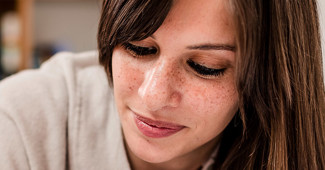Protecting your child’s vision
Our Richmond Health Centre optometrist Jane Chong shares tips on how to manage your child’s existing short-sightedness or even prevent it from developing. This could be even more important during the COVID-19 pandemic, with recent studies suggesting that spending more time on screens and less time outdoors may be increasing short-sightedness in our kids. (To find out more, check out this article by Optometry Australia.)
Understanding the risks
You may think the biggest challenge for parents of short-sighted kids is persuading their child to wear their glasses. But there are broader eye health risks associated with short-sightedness (myopia) that all parents should be aware of.
For instance, a prescription of:
- -1.00D (dioptres) doubles your child’s chance of developing a cataract later in life
- -2.00D increases the risk of a retinal detachment three-fold
- -5.00D means a 41-times higher risk of developing myopic maculopathy, a disease which causes permanent loss of central vision.
Risk factors
Myopia tends to worsen quicker in younger childhood, compared to older teenagers and adults, so early intervention is important. Your child may be at risk of progressive short-sightedness if one or more of these factors apply:
- Their myopia was first noticed before 9 years of age
- Southeast Asian heritage
- One or both biological parents are short-sighted
- They’ve been diagnosed with a binocular vision disorder by their optometrist.
What you can do
Although there’s nothing you can do to change many of the risk factors, there are steps you can take to reduce your child’s risk of developing short-sightedness, or the progression of an existing condition.
- Encourage outdoor play. Spending time outdoors – like playing in the backyard or going for a walk – for at least 90 minutes a day reduces a child’s risk of developing short-sightedness.
Time outdoors hasn’t been proven to slow the progression of existing myopia, but many clinicians will still recommend it for myopic children as the findings are still early and there’s no harm in outdoor play with appropriate sun protection.
- Reduce near work. Studies have found more time spent on near focus work (e.g. reading, studying and computer use) increases the risk of children developing myopia. The current recommendations are to keep near work to 2 hours or less per day, while also maintaining good visual habits.
Like time outdoors, reducing time spent on near work hasn’t yet been shown to reduce myopia progression in children with existing short-sightedness, but many optometrists recommend it as part of healthy visual hygiene.
- If your child has glasses, make sure they wear them. It’s well-proven that the risk and rate of myopia progression is accelerated in short-sighted children whose short-sightedness is under-corrected or isn’t corrected at all.
Contrary to old wives’ tales, wearing glasses prescribed by your optometrist doesn’t weaken eyes, and not wearing them can cause more harm. As much as practical, your child should wear their glasses for short-sightedness full-time.
Personalised advice
Get in touch to talk about slowing the progression of your child’s existing short-sightedness. This might include multifocal or bifocal glasses, multifocal contact lenses, orthokeratology rigid lenses or pharmaceutical eye drops.


